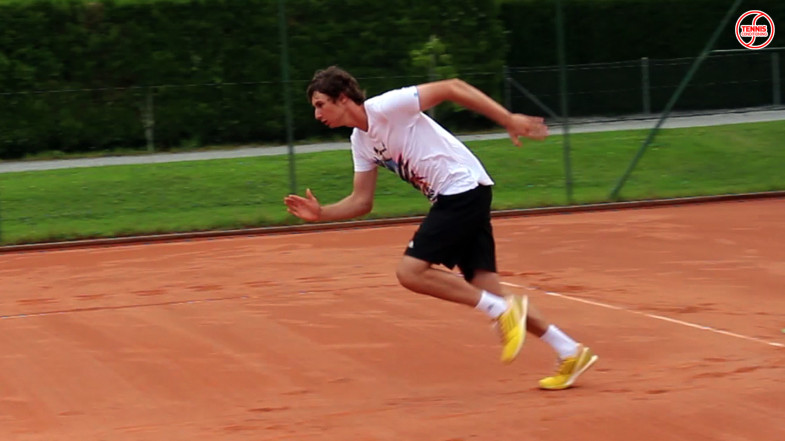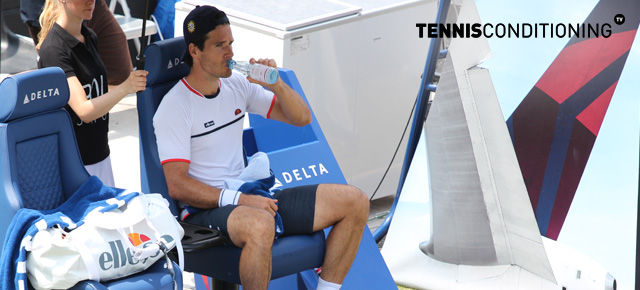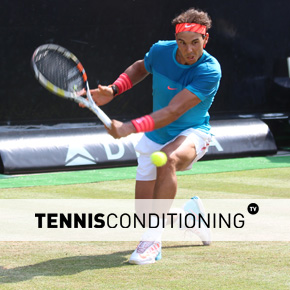Sure, tennis players go jogging and jogging definitely has its benefits. Yet from a tennis conditioning standpoint you could use your precious time better!
Many tennis coaches require their players to include jogging into their regular training program in order to maintain or enhance endurance capabilities.
Jogging or Interval Training?
But from a tennis conditioning standpoint continuous steady-state jogging is inefficient and hence a waste of time. Why?
Because during a tennis match the intensity is rather high with rallies lasting 10-15 seconds on average depending on court surface and skill level.
Followed by approx. 20 sec of rest in between points and total running distance usually doesn’t exceed 1.5miles per best-of-three match.

In order to mimic the metabolic demands we can use more effective training components, such as interval training, that allow the athlete to improve additional performance parameters, such as dynamic stability, besides improving aerobic energy system efficiency (endurance capabilities).
More specifically, instead of (for example) 60 minutes steady state jogging, tennis players should engage in interval training of approximately 45 minutes, where each interval consists of 7 – 8 minutes of interval work, where the athlete sprints 10 sec & lightly jogs 25 – 30 sec.
Once the interval work is accomplished, the athlete gets a 90 second break.
Energy System Contribution During Competition
With regards to energy system dynamics, a tennis player requires contributions from all three energy systems (ATP-CP, Anaerobic Glycolysis, Oxidative Rephosphorylation) during a match.
But the anaerobic energy systems (ATP-CP, Anaerobic Glycolysis) predominate and hence improving their capabilities should be emphasized during training.

Jogging is inefficient because it requires a lot of time and targets the “wrong” energy system.
It mainly enhances the aerobic energy system (Oxidative Rephosphorylation) and slow twitch muscle fiber recruitment but neglects the anaerobic energy systems and fast twitch muscle fiber recruitment.
So, why would you send the athletes jogging for hours each week if that time could be used much more beneficial?
Interval Training
Interval training is characterized by alternating low – and high exercise intensities over a prolonged period of time. It enhances the efficiency of bioenergetic processes (energy transfer) for aerobic and anaerobic energy pathways.
It mirrors and optimizes the metabolic demands (energy system dynamics) experienced during a tennis match and hence is a much more sport-specific form of training.
Depending on age, gender, level of play, and court surface, work-to-rest ratios during a tennis match vary.
Remember, total running distance though usually doesn’t exceed 1.5 miles per best-of-three match
Now, according to the ITF rule book, during professional play there are rest intervals of:
- 20 seconds between points
- 90 seconds during change-overs
- 120 seconds between sets
Work-to-Rest Ratios

Let’s assume that, on average, a point lasts 10-15 seconds and 7 points are being played per game.
That means that a game lasts (7x20sec = 140 sec rest; 7x10sec = 70sec of work // 7x15sec = 105sec of work => 140sec + 70sec = 210sec // 140sec + 105sec = 245sec => 210sec to 245sec = 3min 20sec — 4min 5sec) approximately 3 ½ – 4 minutes, of which 1 – 1 ½ min are of high intensity work and 2 ½ minutes of low intensity (rest) activity.
Therefore, on average, the work-to-rest intervals during a tennis match are 1:2 ½ to 1:3.
That means 10 seconds of high intensity activity follow 25 – 30 seconds of lower intensity activity. That means that during interval training the athlete sprints for 10 seconds and lightly jogs for 25 – 30 seconds.
Now, each game lasts approximately 3 ½ – 4 minutes and 2 games are played before there is another 90 second rest interval due to change-over.
Therefore, we have 7 – 8 minutes of interval work before the athlete gets a 90 second break.
That means that the athlete alternates 10 sec sprinting & 25 – 30 sec light jogging for 7 – 8 minutes before getting 90 seconds to recover.
Therefore, if each interval includes the duration of 2 games and 10 games are played per set, then 5 intervals will represent a set.
That means that an interval training session of 5 intervals will last 41 – 46 minutes (7 min x 5 = 35 min; 8 min x 5 = 40 min // 4×90 sec = 360 sec = 6 min of recovery).
Related Articles To Jogging
- Tennis Circuit Training
- Importance of Aerobic Energy System Efficiency in Tennis
- Interval Training: How to Get Fit for Tennis
Training Zone
In this section we provide you with some more workouts and training tips you may be interested in to optimize your training:




